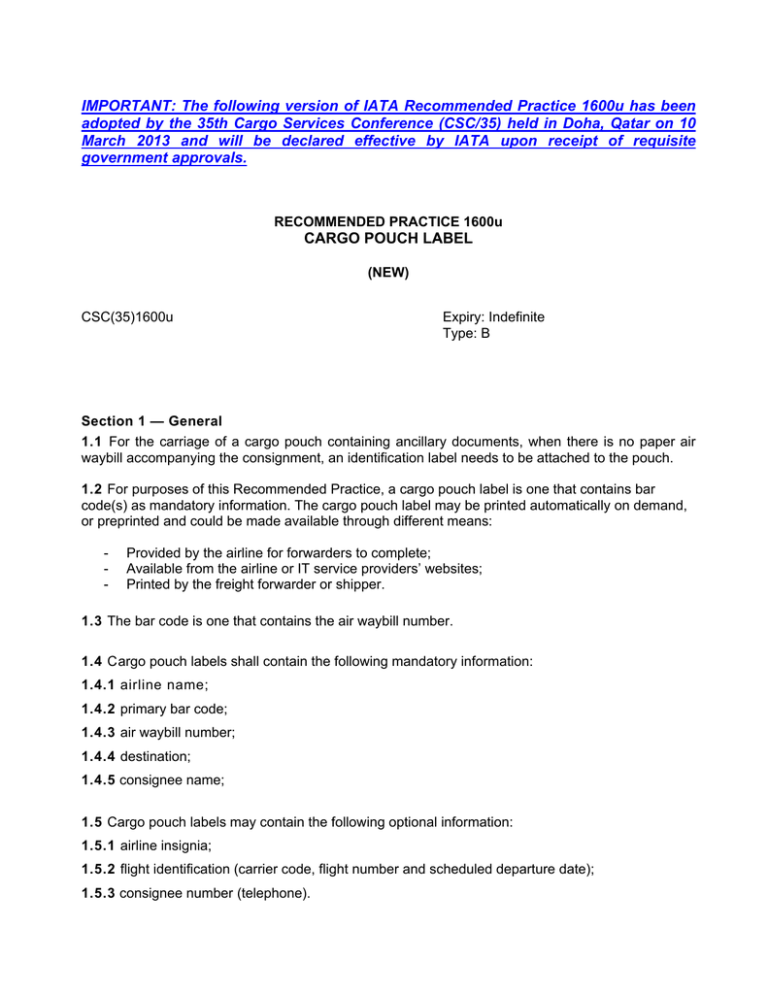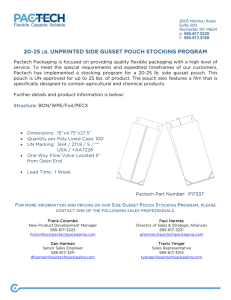IMPORTANT: The following version of IATA Recommended Practice
advertisement

IMPORTANT: The following version of IATA Recommended Practice 1600u has been adopted by the 35th Cargo Services Conference (CSC/35) held in Doha, Qatar on 10 March 2013 and will be declared effective by IATA upon receipt of requisite government approvals. RECOMMENDED PRACTICE 1600u CARGO POUCH LABEL (NEW) CSC(35)1600u Expiry: Indefinite Type: B Section 1 — General 1.1 For the carriage of a cargo pouch containing ancillary documents, when there is no paper air waybill accompanying the consignment, an identification label needs to be attached to the pouch. 1.2 For purposes of this Recommended Practice, a cargo pouch label is one that contains bar code(s) as mandatory information. The cargo pouch label may be printed automatically on demand, or preprinted and could be made available through different means: - Provided by the airline for forwarders to complete; Available from the airline or IT service providers’ websites; Printed by the freight forwarder or shipper. 1.3 The bar code is one that contains the air waybill number. 1.4 Cargo pouch labels shall contain the following mandatory information: 1.4.1 airline name; 1.4.2 primary bar code; 1.4.3 air waybill number; 1.4.4 destination; 1.4.5 consignee name; 1.5 Cargo pouch labels may contain the following optional information: 1.5.1 airline insignia; 1.5.2 flight identification (carrier code, flight number and scheduled departure date); 1.5.3 consignee number (telephone). 1.6 Cargo pouch label quality should be of a type with adequate characteristics. These specific characteristics include: 1.6.1 adhesion holding power; 1.6.2 service temperature range; 1.6.3 moisture resistance. Section 2 — Technical Specifications 2.1 The layout and minimum dimensions of Cargo pouch labels are defined in Attachment ‘B’ and ‘C’ of this Recommended Practice. Attachment ‘C’ also shows completed examples. 2.2 Bar coded information shall be in accordance with Recommended Practice 1600t and as shown in Attachments ‘A’ of this Recommended Practice. 2.3 Notwithstanding the provisions of this Recommended Practice, carriers and their customers who use the Cargo pouch labels of different dimensions may continue to use them, provided the data encoding requirements specified in Attachments ‘A’ of this Recommended Practice are met. Section 3 — Completion 3.1 The circled numbers to the right of the titles below, correspond with the numbers in the boxes of the specimen label illustrated in Attachment ‘B’ of this Recommended Practice. 3.2 Completion of the mandatory boxes on the labels shall be as shown below: 3.2.1 Airline Name 1 The airline name. 2 3.2.2 Primary Bar Code The primary bar code contains all data elements described in Attachment ‘A’ of this Recommended Practice. 3.2.3 Air Waybill Number 3 The airline prefix and air waybill number of the shipment. The serial number may be shown as two groups of four digits. 3.2.4 Destination 4 The IATA three-letter code of the airport of destination. When the airport code is unknown or the city is served by more than one airport the IATA three-letter city code may be used. 3.2.5 Consignee Name 5 The name of the consignee. 3.3 When used, completion of the optional information on the labels shall be as follows: 6 3.3.1 Airline Insignia The airline insignia. 3.3.2 Flight Identification 7 The IATA two-character carrier code of the airline followed by the flight number, a slant and scheduled departure date. 3.3.3 Consignee Number 8 The telephone number for the consignee. RECOMMENDED PRACTICE 1600u Attachment ‘A’ Primary Bar Code (Air Waybill Number) A primary bar code, of eleven continuous numeric characters, in which the encoded data shall comprise the following fields: = the three-digit numeric airline prefix; = the eight-digit numeric air waybill number. N o t e : The barcode may have human readable translation of all digits in the field. Examples: (a.) air waybill 77712345675, 77712345675 The primary bar code shall be printed on the bar coded cargo pouch label as indicated in Attachments ‘C’ and ‘D’. There should be no box around the bar code in order to maximise reading efficiency. The bar code shall be printed in Code 128 with a minimum width of the narrow bar (× dimension) of 0.5 mm (0.02 in). The bar code shall be printed vertically (picket fence) with a minimum bar height of 21.6 mm (0.85 in). The bar code includes the following top and bottom quiet zones: The side quiet zones shall be as specified in Recommended Practice 1600t. The optical characteristics of the bar code shall be such as to be readable: = using a contact scanner (wand reader); = at a distance of up to 1.80 m (6 ft) using a non-contact scanner; = using a fixed scanner on a conveyor moving at speeds of approximately 1.80 metres per second (6 feet per second) and a depth of field ranging from 12.7 to 803mm (1~2 to 32 in). RECOMMENDED PRACTICE 1600u Attachment ‘B’ Cargo Pouch Label Format RECOMMENDED PRACTICE 1600u Attachment ‘C’ Cargo Pouch Label Example Mandatory RECOMMENDED PRACTICE 1600u Attachment ‘C’ Example Optional

